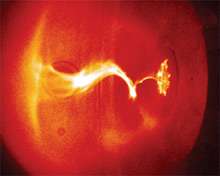 |
| A "kinky" plasma jet. Photo credit: http://ve4xm.caltech.edu/Bellan_plasma_page/ |
Scientists are increasingly turning to laboratory-based experiments to gain insight into the mechanisms that affect plasmas in space. Speakers at a handful of sessions at the APS April meeting in Dallas described some of their recent work in this area, shedding light on such questions as solar flares, the temperature of the sun’s corona, astrophysical jets, and the interiors of neutron stars.
Many of the complex phenomena seen in space are difficult to understand with existing theories. This is partly due to the fact that much of the universe is made of plasmas, which exhibit highly complex behavior. Thus, it can be difficult to come up with good mathematical models. Physicists can predict the behavior of individual fluid particles, but plasmas are comprised of very large numbers of particles that are constantly in motion. They are also charged particles, so their motion is affected by electric and magnetic fields, especially the magnetic fields of nearby stars and galaxies.
Plasma-related phenomena can be seen in the sun's periodic solar flares, which eject powerful bursts of charged particles so strong they can sometimes interfere with earth-bound communications. Michael Brown, a physicist at Swarthmore College, has created scaled-down experimental versions of solar phenomena in the laboratory, building arrays of wire loops to study magnetic reconnection in plasmas. Magnetic fields are forced together, like two strands of a rope, and annihilate each other, producing a burst of excess energy. This accelerates the plasma outward to produce a solar flare.
Brown's laboratory plasmas are about one foot tall whereas those on the sun are about five times the diameter of Earth, but the temperature of the gas and the strength of the magnetic field are about the same in both cases. Among other things, such studies may help solve the mystery of why the temperature of the sun's corona is so much hotter than the core.
The jet plumes of plasma emitted by certain galaxies are the focus of the laboratory simulations produced by Caltech's Paul Bellan. As matter falls inward toward a star or black hole, forming an accretion disk, the jets shoot out along the axis of the disk.
Even small jets are roughly the size of our solar system. Bellan's lab-based jets are a mere 20 inches tall, and while he admits it is not an exact model, nonetheless they exhibit the same underlying physics, and can therefore provide insight into the mechanisms at work in the large-scale jets.
Magnetic lines of force are believed to both drive astrophysical jets and cause their collimated profile. The lab-sized jets are produced through magnetic lines of force, generated via lots and lots of power: on the order of 200 million watts in the laboratory simulations. Bellan's lab cuts down on those costs by using short, extremely powerful magnetic pulses every few seconds.
To create his plasmas in the laboratory, Bellan uses a copper disk and an annulus to simulate the accretion disk that surrounds a black hole. A coil provides the initial "seed" magnetic field for the confined gas, which can be broken down to form a plasma by the judicious application of several kilovolts of electric current across the disk and annulus. The current first flows along the path created by the seed magnetic field, creating a pattern that looks for all the world like "spider legs." The attractive forces concentrate the current into a jet, and the repulsive magnetic forces speed it up so the spider legs get bigger and bigger. Eventually the jet undergoes a "kink instability," coiling up like a twisted telephone cord and shooting outward.
University of Iowa physicist John Goree is creating small-scale versions in the lab of so-called "dusty plasmas," and using them to simulate and study the propagation of waves through the plasma–which appear to behave much like the shock waves generated along the crusts of neutron stars (see 'Starquakes' Reveal Clues About Magnetar Composition). Dusty plasmas make up the tails of comets and the rings of Saturn.
Goree creates his mini-dusty plasmas by dropping polymer microspheres–the "dust"–into a glow discharge plasma. The dust can absorb electrons and ions because its particles are so much heavier, giving the dusty plasmas a negative charge and changing their behavior. Goree then videotapes the particles' behavior, which mimics that of dusty space plasmas.
©1995 - 2024, AMERICAN PHYSICAL SOCIETY
APS encourages the redistribution of the materials included in this newspaper provided that attribution to the source is noted and the materials are not truncated or changed.
Associate Editor: Jennifer Ouellette
Staff Writer: Ernie Tretkoff
June 2006 (Volume 15, Number 6)
Articles in this Issue

